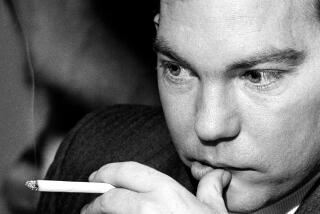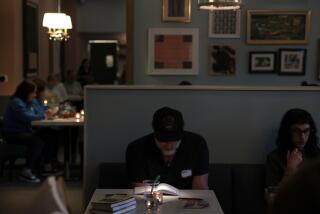SILVER CITY.<i> By Li Rui</i> . <i> Translated from the Chinese by Howard Goldblatt</i> .<i> Metropolitan: 278 pp., $25</i>
- Share via
On Oct. 24, 1951, in the provincial salt-mining town of Silver City in interior China, Commander Three Ox Wang fervently shouted the order to “[d]rag the counterrevolutionaries to the execution ground and carry out the sentences!” Wang’s order was swiftly carried out, leaving 108 dead, 32 of whom were members of the once-powerful Li clan. The only adult male belonging to the clan who did not stand before the firing squad was Li Naizhi, a fraternal (?) cousin to the first man shot, Li Naijing. During the execution, Naizhi was miles away in a suburb of Beijing, where, from his Stalin 55 tractor, he led the first graduating class of tractor trainees outside of Beijing in the suburb of Tandang. Film crews and journalists recorded the event, “creating scenes that would become the defining images of New China’s historic national project . . . .”
Li Rui, born in Beijing in 1950, one year after the creation of the People’s Republic, moves backward and forward in time as he examines the events and relationships that led to the historic juxtaposition so dramatically rendered in the opening pages of “Silver City,” his first novel to appear in English.
One of China’s leading writers of popular fiction, Li is part of a broader movement in China that has concerned itself with cultural examination. Particularly since the late 1970s, many writers, filmmakers and other artists in China have viewed aesthetic considerations as intimately linked to cultural and political definition. Li can be placed specifically among those fiction writers who have focused on people living in small suburban locales, drawing on local color, and sometimes myth, within a framework of literary realism.
During a conference on art and activism in 1989, Li spoke about the influence of “Confucian thinking” on traditional Chinese literature, noting that it “tends to stress the didactic and political function of literature.” Li’s comments shed light on the unabashedly propagandistic writings of the Cultural Revolution, showing this didactic impulse taken to its extreme. Since the revolution, this tendency has been joined with an effort to realistically portray public and private lives with all their complexities. Li succeeds in these aims, bringing, as he does in “Silver City,” the passions of romance, family strife and politics vibrantly to life.
Focusing primarily on the Li clan, Li dramatizes the effects of economic misfortune as he traces the rise and fall of their holdings in Silver City’s primary industry. Beginning in 25 AD, the clan flourished for nearly 2000 years, surviving wars and the reigns of a variety of dynasties, finally settling to build a city and open a salt mine. The mine in Silver City was said to be the first of its kind and “therefore among the most important scientific discoveries in China.” But in 1928, when Li Naijing stood as patriarch of the Li clan, the mine was not producing well, causing family wealth and status to diminish. These losses fell hard on Naijing’s orphaned nieces and nephews. When learning that her younger brother Naizhi would be unable to attend college, Li Zuhen, who had mothered Naizhi and their younger sister Ziyun after the early death of their parents, took drastic measures. Having already turned down several marriage proposals, Zuhen insured her spinster status by disfiguring her face, planning to devote herself instead to supporting her brother and sister. Using burning joss sticks, she “jabbed the glowing tips into her cheeks” and then pricked her finger, “writing the word Buddha in her own blood” and vowing to lead a life of sexual abstinence.
Moved by the immense sacrifice made by his niece, Naijing became fiercely motivated to bring the mines back into productivity, and by outmaneuvering a business associate, he succeeded. But further complications ensue: Although Naizhi is drawn to university study, he feels tremendously ambivalent about leaving the sister who had sacrificed so much for him. And after the outcome of the December 1927 Communist insurrection led by teachers and students from the local high school, during which 3,800 peasants were killed, his passions began turning away from the family business. Naizhi’s most revered teacher, a leader of the insurrection, was executed and beheaded along with another of the revolt’s leaders. For months, their heads hung above the entrance to Silver City, engendering in Naizhi a passionate drive to continue their struggle for revolution.
Through a shifting perspective, which Li achieves by having first one and then another key character take up the narrative so that certain events are recounted multiple times, he suggests the complexity of the events themselves and the intricacy of the relationships among their participants. His tone shifting from matter of fact to mildly ironic, Li demonstrates that despite profound family loyalty, an uncle and nephew like Naijing and Naizhi might find themselves pitted against one another, resulting with the former being executed by the comrades of the latter. Li’s willingness to critique both sides of the revolution, as well as certain violent tendencies embedded in Chinese culture--reflected in the grotesque beheadings and in Zuhen’s self-mutilation--lends compelling credibility to this moving account of China’s recent past.
More to Read
Sign up for our Book Club newsletter
Get the latest news, events and more from the Los Angeles Times Book Club, and help us get L.A. reading and talking.
You may occasionally receive promotional content from the Los Angeles Times.








